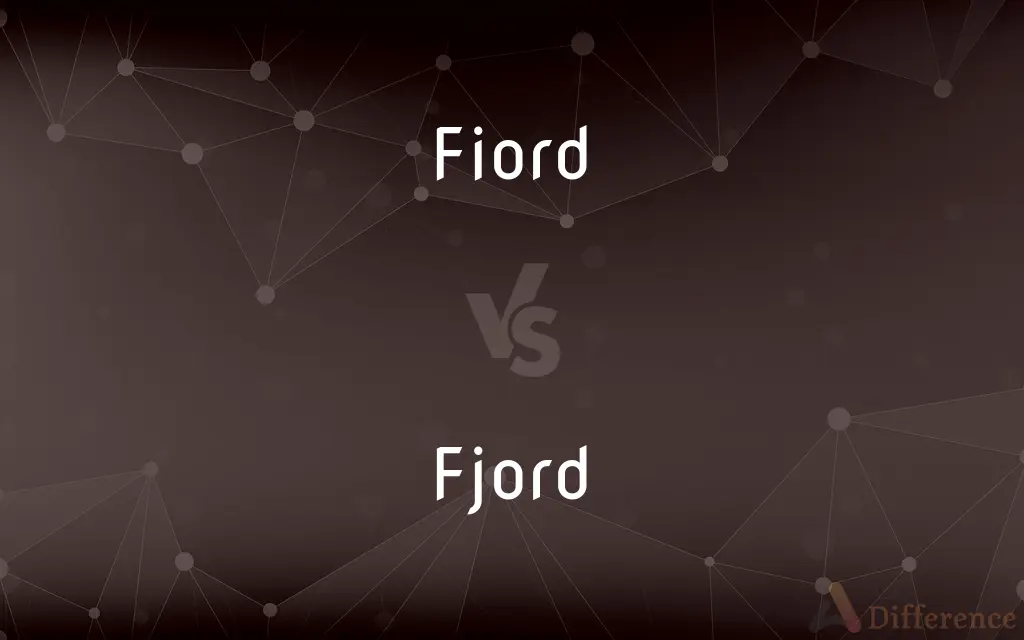Fiord vs. Fjord — What's the Difference?
By Tayyaba Rehman & Maham Liaqat — Updated on March 10, 2024
Fiord and fjord both refer to narrow, deep waterways carved by glacial activity, but "fjord" is the preferred spelling in most contexts, originating from Norwegian.

Difference Between Fiord and Fjord
Table of Contents
ADVERTISEMENT
Key Differences
Fiord and fjord describe narrow, steep-sided inlets created by glacial erosion.
While both terms are often used interchangeably, "fjord" is the more commonly accepted spelling outside New Zealand, where "fiord" is preferred.
These inlets are characterized by their deep waters and dramatic landscapes, often found in regions that were heavily glaciated, such as Norway, New Zealand, and parts of Canada.
Fjords are renowned for their scenic beauty, attracting tourists and nature enthusiasts alike. On the other hand, the usage of "fiord" reflects regional spelling preferences and does not indicate a significant difference in the physical characteristics of the waterway.
Comparison Chart
Spelling Preference
Preferred in New Zealand
Commonly used internationally, especially in Norway
ADVERTISEMENT
Origin of Term
English adaptation
Norwegian origin
Geological Feature
Deep, glacially carved inlet
Deep, glacially carved inlet
Scenic Value
High, with dramatic landscapes and deep waters
High, with dramatic landscapes and deep waters
Usage Context
Specific to regional preference; less common globally
Widely recognized and used in scientific and general contexts
Compare with Definitions
Fiord
A narrow, steep-sided inlet of the sea formed by glacial erosion.
The fiord's crystal-clear waters are surrounded by towering cliffs.
Fjord
A deep, narrow, and elongated sea or lake drain, with steep land on three sides, formed by glacial activity.
The fjord cuts through the landscape, flanked by snow-capped mountains.
Fiord
Fiords are prominent in New Zealand's landscape, showcasing the country's glaciated past.
Milford Sound is one of New Zealand's most famous fiords, attracting visitors from around the world.
Fjord
Fjords are carved by the movement of glaciers, leaving behind steep valleys filled with seawater.
The geology lecture explained how fjords were formed during the last Ice Age.
Fiord
Fiords support diverse marine and terrestrial ecosystems.
The fiord's nutrient-rich waters are a haven for fish and birdlife.
Fjord
Norway's fjords are among the most iconic and visited natural attractions in the world.
The stunning beauty of Norway's fjords is unmatched, drawing nature lovers from across the globe.
Fiord
Fiords often feature breathtaking scenery, including waterfalls and wildlife.
Kayaking through the fiord offered unforgettable views of seals lounging on the rocks.
Fjord
Fjords provide unique settings for outdoor activities, including fishing, hiking, and skiing.
Skiing down the slopes with the fjord below was an exhilarating experience.
Fiord
Many fiords are accessible to tourists, offering boat tours and hiking trails.
The fiord was bustling with tourists eager to catch a glimpse of its majestic beauty.
Fjord
Fjords have played a crucial role in the development of communities, serving as natural harbors and fishing grounds.
The village nestled by the fjord has a rich history of Viking explorers and seafarers.
Fiord
Variant of fjord.
Fjord
In geology, a fjord or fiord (alternatively fyord) ( (listen)) is a long, narrow inlet with steep sides or cliffs, created by a glacier. There are many fjords on the coasts of Alaska, Antarctica, British Columbia, Chile, Denmark, Greenland, the Faroe Islands, Iceland, Ireland, Kamchatka, the Kerguelen Islands, New Zealand, Norway, Novaya Zemlya, Labrador, Nunavut, Newfoundland, Quebec, Scotland, South Georgia Island, Isla de los Estados, and Washington state.
Fiord
Alternative spelling of fjord
Fjord
A long, narrow, deep inlet of the sea between high cliffs, as in Norway, typically formed by submergence of a glaciated valley.
Fiord
A narrow inlet of the sea, penetrating between high banks or rocks, as on the coasts of Norway and Alaska.
Fjord
A long, narrow, deep inlet of the sea between steep slopes, especially one shaped by glacial action.
Fiord
A long narrow inlet of the sea between steep cliffs; common in Norway
Fjord
A long, narrow, deep inlet between cliffs.
Fjord
See Fiord.
Fjord
A long narrow inlet of the sea between steep cliffs; common in Norway
Common Curiosities
What is a fjord?
A fjord is a deep, narrow waterway with steep sides or cliffs, created by glacial action, prevalent in Norway.
Where are fjords most commonly located?
Fjords are famously located in Norway, but can also be found in countries with glaciated terrains, such as Canada and New Zealand.
What is a fiord?
A fiord is a steep-sided, narrow inlet formed by glacial erosion, commonly found in New Zealand.
What is the significance of fjords in glacial studies?
Fjords are key in understanding glacial and post-glacial processes, serving as natural laboratories for scientists.
How do fiords and fjords contribute to biodiversity?
Their unique ecosystems support a wide range of biodiversity, from marine life to bird species.
Are there any ecological differences between fiords and fjords?
No, the ecological characteristics are similar, supporting diverse marine and terrestrial ecosystems.
Why is "fjord" the preferred spelling in international contexts?
"Fjord" is derived from Norwegian, reflecting its origins and widespread acceptance in global discussions on glacial geography.
How are fiords and fjords formed?
Both are formed by the carving action of glaciers moving down mountains, eroding the landscape and creating deep inlets.
Where can fiords be found?
Fiords are notably found in New Zealand, where the spelling "fiord" is preferred.
Can fjords and fiords be used interchangeably?
Yes, the terms can be used interchangeably, though "fjord" is more widely accepted internationally.
Do fiords and fjords play a role in local cultures?
Yes, they have historically been vital for local communities, providing natural harbors, fishing grounds, and influencing cultural development.
How do fjords affect the climate of surrounding areas?
They can influence local climates by funneling and moderating sea breezes, often creating microclimates.
What is the main difference in the usage of "fiord" and "fjord"?
The main difference lies in regional spelling preferences, with "fiord" used primarily in New Zealand and "fjord" used internationally.
What makes fjords and fiords attractive to tourists?
Their dramatic landscapes, including high cliffs, deep waters, and scenic beauty, make them popular tourist destinations.
What activities can be done in fjords and fiords?
Activities include boating, kayaking, hiking, fishing, and enjoying the scenic beauty.
Share Your Discovery

Previous Comparison
Homemaker vs. Housewife
Next Comparison
Guiacum vs. GuaiacumAuthor Spotlight
Written by
Tayyaba RehmanTayyaba Rehman is a distinguished writer, currently serving as a primary contributor to askdifference.com. As a researcher in semantics and etymology, Tayyaba's passion for the complexity of languages and their distinctions has found a perfect home on the platform. Tayyaba delves into the intricacies of language, distinguishing between commonly confused words and phrases, thereby providing clarity for readers worldwide.
Co-written by
Maham Liaqat












































